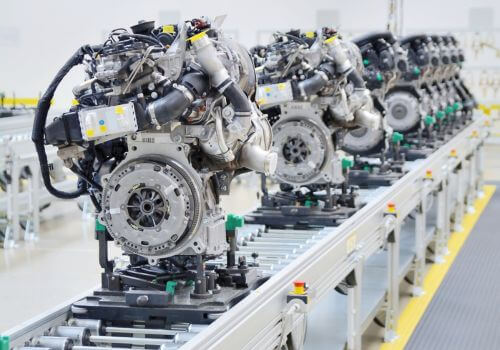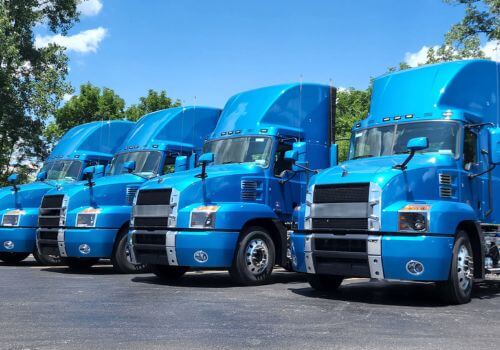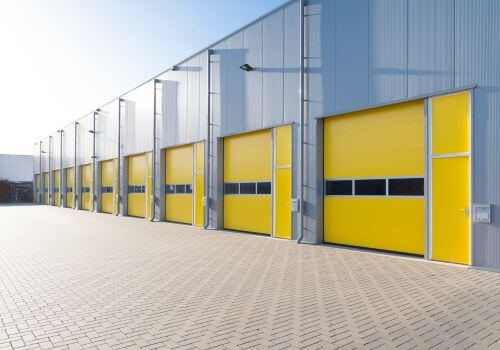The transportation and logistics industry in the United States is a vital component of the economy, responsible for moving billions of tons of freight each year. Trucks, as the backbone of this industry, play a crucial role in ensuring goods are delivered efficiently across the nation’s vast network of highways and roads. Each type of truck is designed to meet specific transportation needs, from moving everyday consumer products to hauling oversized industrial machinery. In this article, we’ll take a look at the top 10 most common types of transportation trucks you’ll find on American roads, exploring their features, uses, and importance in today’s logistics ecosystem.
1. Dry Van Trucks
Dry van trucks are the workhorses of the freight transportation industry. These are the most commonly used trucks in United States, recognizable by their fully enclosed trailers. Dry vans are versatile and are typically used to transport non-perishable goods, making them a staple in the supply chain.
Truck features
A standard dry van trailer is usually 53 feet long, although shorter versions are also available. The enclosed structure protects cargo from external elements such as weather, road debris, and theft. Dry van trailers are usually loaded through rear doors, and some models offer side door access for easier loading and unloading.
Usage
Dry van trucks are used to transport a wide range of goods, including electronics, packaged food, clothing, household goods, and furniture. Their versatility makes them ideal for transporting any cargo that does not require refrigeration or special handling. Retailers, manufacturers, and distributors rely heavily on dry vans to move goods from distribution centers to retail stores and warehouses.
Importance in the industry
The prevalence of dry van trucks is a testament to their essential role in the logistics industry. They are often the first choice for general freight transportation due to their ability to handle a variety of cargo types. The enclosed design ensures that goods arrive in the same condition as they were loaded, making them indispensable for transporting high-value items.
2. Flatbed Trucks
Flatbed trucks are another common sight on U.S. highways, known for their open design. Unlike dry vans, flatbeds do not have sides or a roof, allowing them to carry oversized or irregularly shaped cargo that wouldn’t fit in an enclosed trailer.
Truck features
Flatbed trailers typically range from 48~53 feet in length and are usually around 8.5 feet wide. The flat, open bed allows for easy loading and unloading from all sides, often using cranes or forklifts. The open design, however, requires cargo to be secured with straps, chains, or tarps to prevent shifting during transit.
Usage
Flatbeds are essential for transporting construction materials like steel beams, lumber, and concrete pipes, as well as large machinery and equipment. They are also used to haul oversized loads, such as prefabricated homes, large industrial tanks, and other items that exceed the dimensions of a standard trailer.
Importance in the industry
Flatbed trucks play a critical role in industries that require the transport of large, heavy, or awkwardly shaped goods. Their versatility in handling a variety of load types makes them indispensable in construction, manufacturing, and agriculture sectors. Without flatbeds, many large-scale infrastructure projects would be difficult, if not impossible, to complete.
3. Refrigerated Trucks (Reefers)
Refrigerated trucks, commonly referred to as reefers, are specialized vehicles designed to transport perishable goods that need to be kept at specific temperatures during transit. These trucks are essential for the food and pharmaceutical industries, where maintaining the integrity of the cargo is critical.
Truck features
Reefer trailers are similar in size to dry vans, typically 53 feet long, but they are equipped with refrigeration units that can maintain temperatures ranging from -20°F to 70°F. The interior of a reefer is insulated to ensure temperature control, and many models feature multiple temperature zones for transporting different types of goods simultaneously.
Usage
Reefers are primarily used to transport fresh produce, frozen foods, dairy products, meats, seafood, and pharmaceuticals. They are also used for transporting certain types of chemicals and other temperature-sensitive materials. The ability to maintain a controlled environment makes reefers crucial for industries that rely on the freshness and safety of their products.
Importance in the industry
The refrigerated transport industry is a vital component of the global food supply chain. Reefers ensure that perishable goods can be transported over long distances without spoiling, allowing for the distribution of fresh food year-round, regardless of season. This capability is especially important in the U.S., where food is often transported across thousands of miles from farms to consumers.
4. Tanker Trucks
Tanker trucks are designed for transporting liquids and gases, and they play a crucial role in industries such as oil, gas, and chemicals. These trucks are specialized to carry a variety of liquid commodities, ranging from water to highly flammable fuels.
Truck features
Tanker trailers vary in size and capacity, with common configurations holding between 5,000 to 11,000 gallons of liquid. The tanks are cylindrical and can be made from different materials, including aluminum, stainless steel, or carbon steel, depending on the cargo. Tankers often come equipped with specialized pumping systems and valves to facilitate the safe loading and unloading of liquids.
Usage
Tanker trucks are used to transport gasoline, diesel, oil, chemicals, milk, water, and other liquid goods. They are also used in the food industry to transport bulk liquids like corn syrup, wine, and juice. Hazardous materials tankers are specially designed to handle dangerous substances, such as acids or chemicals, requiring strict safety protocols during transport.
Importance in the industry
The transportation of liquids is a specialized and essential service in many industries. Tanker trucks enable the efficient and safe movement of large quantities of liquids, making them critical for the energy, chemical, and agricultural sectors. Their ability to transport hazardous materials safely is also vital for protecting public health and the environment.
5. Step Deck (Drop Deck) Trucks
Step deck trucks, also known as drop decks, are similar to flatbeds but with a lower deck height, making them ideal for transporting tall loads without exceeding height restrictions. This design allows them to carry a wider range of cargo compared to standard flatbeds.
Truck features
Step deck trailers have two deck levels: an upper deck closer to the cab and a lower deck that drops down. The lower deck typically sits about 3.5 feet above the ground, providing more height clearance for taller loads. Step deck trailers are usually 48~53 feet long and are equipped with ramps for loading vehicles and equipment.
Usage
Step deck trucks are commonly used to transport heavy machinery, industrial equipment, vehicles, and oversized freight. Their ability to accommodate taller loads makes them ideal for transporting items like tractors, cranes, and large construction materials.
Importance in the industry
Step deck trucks are essential for industries that need to move tall and heavy equipment. Their unique design allows for the safe transport of oversized loads that would otherwise be challenging to haul on standard flatbeds. This capability makes them invaluable for construction, agriculture, and manufacturing sectors, where large equipment is frequently moved from one site to another.
6. Lowboy Trucks
Lowboy trucks are a type of flatbed trailer with an extremely low deck, designed to transport heavy and oversized equipment that cannot be carried by standard flatbeds or step decks. Their low profile makes them the go-to option for transporting tall and heavy machinery.
Truck features
Lowboy trailers typically have a deck height of 12~18 inches above the ground, which allows them to carry loads up to 12 feet tall without exceeding federal height restrictions. They usually have two drops in deck height: one after the gooseneck and one before the rear wheels. Lowboys can carry loads weighing up to 80,000 pounds or more, depending on the number of axles.
Usage
Lowboy trucks are commonly used to transport heavy construction equipment such as bulldozers, excavators, cranes, and other large machinery. They are also used to move industrial equipment, transformers, and other oversized items that are too large to heavy for other types of trailers.
Importance in the industry
Lowboy trucks are critical for the construction and heavy equipment industries. Their ability to carry extremely heavy and oversized loads makes them indispensable for moving large machinery to and from job sites. Without lowboys, the transport of such equipment would require disassembly or specialized shipping methods, significantly increasing costs and time.
7. Box Trucks
Box trucks, also known as straight trucks or cube vans, are smaller than semi-trailers and are commonly used for local deliveries. They have a cargo area that is separate from the cab, which is fully enclosed to protect the goods inside.
Truck features
Box trucks comes in various sizes, typically ranging from 10~26 feet in length. They have a cargo area that is fully enclosed, with rear roll-up doors for easy access. Some models also feature side doors. Box trucks usually have a gross vehicle weight rating (GVWR) of up to 33,000 pounds, making them suitable for medium-duty hauling.
Usage
Box trucks are widely used for moving household goods, furniture, appliances, and other items that require protection from the elements. They are also commonly used by small businesses for local deliveries, such as distributing products to retail stores or delivering goods directly to customers.
Importance in the industry
Box trucks are a vital component of the last-mile delivery process. Their smaller size and maneuverability make them ideal for navigating urban areas and reaching destinations that larger trucks cannot access. This capability is especially important for businesses that rely on timely and efficient delivery services, such as furniture stores, appliance retailers, and ecommerce companies.
8. Car Carrier Trucks
Car carrier trucks, or auto transporters, are specialized vehicles designed to transport multiple cars simultaneously. These trucks are essential for the automotive industry, enabling the efficient movement of vehicles from manufacturers to dealerships or between locations.
Truck features
Car carrier trailers are typically two-tiered, with hydraulic ramps that allow vehicles to be loaded onto both levels. Depending on the configuration, these trailers can carry between 6~10 vehicles. The trailers are designed with adjustable ramps to accommodate various vehicle sizes, and some models are enclosed to protect high-value vehicles from weather and road debris.
Usage
Car carrier trucks are primarily used by automotive manufacturers, dealerships, and car rental companies to transport vehicles over long distances. They are also used by individuals and businesses moving vehicles for relocation purposes or special events.
Importance in the industry
Car carriers are essential for the automotive supply chain, facilitating the distribution of new vehicles from factories to dealerships across the country. They also play a key role in the secondary market, transporting used cars between auctions, dealerships, and buyers. The efficiency of car carriers ensures that vehicles can be delivered quickly and safely, maintaining the steady flow of inventory to meet consumer demand.
9. Dump Trucks
Dump trucks are heavy-duty vehicles equipped with a hydraulic bed that can be tipped to unload loose materials like sand, gravel, or demolition waste. They are commonly used in construction, mining, and waste management industries.
Truck features
Dump trucks come in various configurations, ranging from smaller, single-axle models to large, multi-axle vehicles with a high payload capacity. The most common type is the standard dump truck, which has a hinged dump bed at the rear that lifts to discharge its contents. The size and capacity of dump trucks vary widely, with some models capable of carrying up to 30 tons of materials.
Usage
Dump trucks are primarily used to transport bulk materials such as sand, gravel, dirt, asphalt, and construction debris. They are also used in mining operations to haul ore and other raw materials. In addition, dump trucks are employed in waste management to transport large volumes of waste to landfills.
Importance in the industry
Dump trucks are essential for the construction and mining industries, where large quantities of materials need to be moved efficiently and safely. Their ability to quickly unload materials makes them ideal for use on job sites, where time and efficiency are critical. In the waste management sector, dump trucks play a crucial role in the collection and transportation of waste, helping to keep cities and towns clean and safe.
10. Garbage Trucks
Garbage trucks are specialized vehicles designed for the collection and transportation of waste. These trucks are a common sight in residential and commercial areas, playing a crucial role in waste management and public health.
Truck features
Garbage trucks come in various types, including front loaders, rear loaders, and side loaders, each designed for different types of waste collection. These trucks are equipped with compactors to maximize the amount of waste they can carry. Some models feature automated arms that can lift and empty trash bins without the need for manual labor. The size of garbage trucks varies, with larger models used for commercial waste collection and smaller ones for residential routes.
Usage
Garbage trucks are used by municipalities and private waste management companies to collect and transport residential, commercial, and industrial waste to landfills, recycling centers, or waste treatment facilities. They are also used for the collection of recyclable materials, helping to reduce the environmental impact of waste.
Importance in the industry
Garbage trucks are a critical component of the waste management system, ensuring that waste is collected and disposed of in a timely and efficient manner. Their role in maintaining public health and sanitation cannot be overstated, as they help prevent the accumulation of waste that could lead to health hazards. In addition, garbage trucks contribute to environmental sustainability by facilitating the collection and processing of recyclable materials.
Conclusion
The transportation and logistics industry in the United States is a complex and vital network that relies heavily on a diverse fleet of trucks to keep goods moving across the country. From the versatile dry van trucks that handle everyday consumer goods to the specialized lowboy trucks that transport massive industrial machinery, each type of truck serves a specific and essential role in the supply chain.
Understanding the different types of trucks and their uses is important for anyone involved in logistics, supply chain management, or transportation. As the industry continues to evolve, with advancements in technology and increasing demands for efficiency, these trucks will remain at the forefront of the nation’s transportation infrastructure.
The diversity of trucks on American roads is a testament to the ingenuity and adaptability of the logistics industry, ensuring that goods of all shapes, sizes, and sensitivities can be transported safely and efficiently. Whether you’re passing a towering flatbed loaded with construction materials or a sleek reefer hauling fresh produce, each truck you see is a critical link in the chain that keeps the economy moving.











